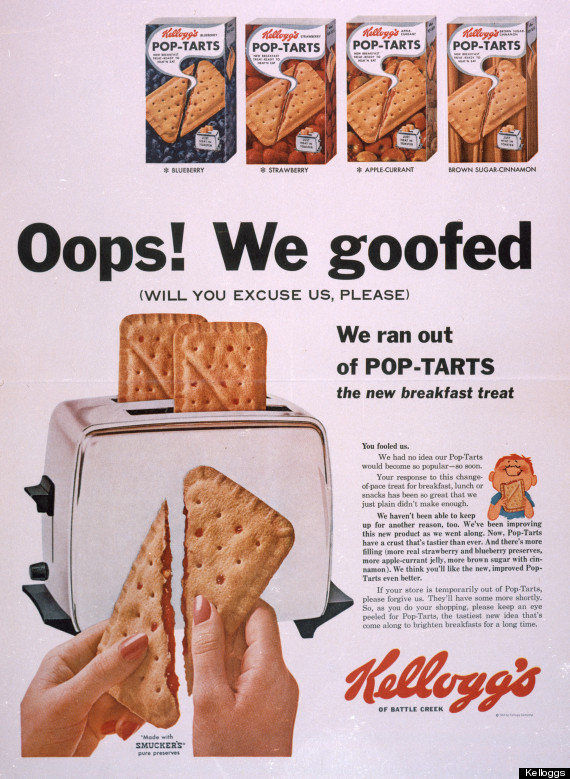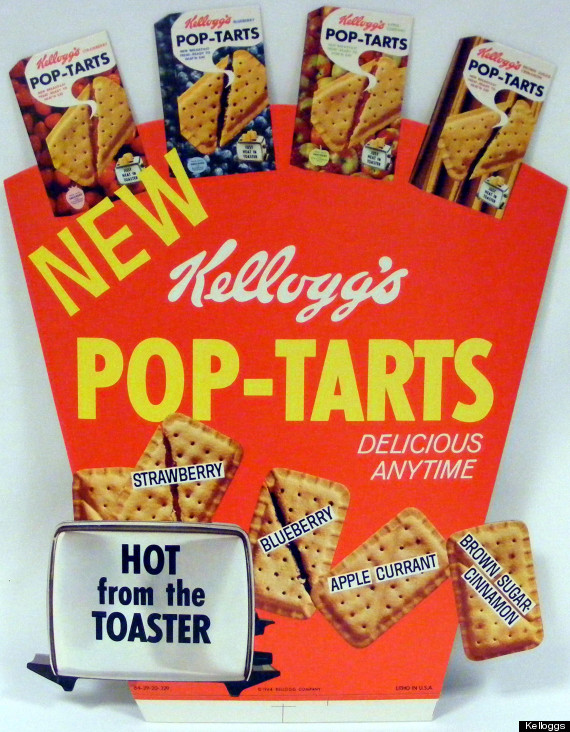Did you know that Kellogg’s Pop Tarts were developed in Michigan? Of course you did.
Post had the idea first.
The worst thing a company can do is tip off a new invention to a competitor before it has passed the trial stage. Luckily for Kellogg’s, Post was a little too eager, and made that exact mistake. Before Pop-Tarts existed, Post was in the process of creating a shelf-stable, fruit-filled pastry. They unveiled their upcoming breakfast pastry, known as Country Squares, to the press on on February 16, 1964, well before it was ready to hit the market. The press ate it up, and so did Kellogg’s.
While Post was busy messing around with the product recipe, Kellogg’s took full advantage and swiftly began working on their own. If Kellogg’s was going to beat its rival to the breakfast-pastry punch, it would need to round up some baking help. Naturally, the company turned to Keebler and recruited Bill Post, the manager of Keebler’s Grand Rapids, Mich. Plant, to start working on what would become Pop-Tarts. Post, the son of Dutch immigrants, had been working at Keebler since his 16th birthday. If anyone had the baking know-how to quickly create a toastable treat, Post was the man.
They are kid tested and dad approved… literally
When Kellogg’s food technologist Bill Post developed the concept of Pop-Tarts, he needed a test panel to try them out. Who better to do that than his own kids? Children have a knack for being honest and Bill’s were no exception. While they didn’t care for many of the products their dad brought them, there was one in particular that they adored — and that was Pop-Tarts.
At the time, Pop-Tarts had not been named yet. Still in their trial period, they referred to them in-house as “fruit scones.” Bill’s kids loved the fruit scones so much they would beg their dad to bring them home. He knew right then that he had a hit on his hands, and he was right. I guess that means we all have Bill Post’s kids to thank for this bit of breakfast nostalgia, and we’re eternally grateful.
Their name was inspired by an iconic American artist
How did Kellogg’s take their fruit-filled pastry from the name Fruit Scones to Pop-Tarts? It’s definitely a big leap, and it all had to do with one famous American pop artist. In the 1960s, Andy Warhol was reaching the height of his popularity as a leader of the pop art movement. Rather than come up with a homey sounding name like their competitor (Country Squares), Kellogg’s wanted something with more of an edge. They decided to take a cue from pop culture and name their product after Andy Warhol’s endeavors.
This lucky city tasted them before anyone else
While Bill Post’s kids may have been the first not on the Kellogg’s payroll to test out Pop-Tarts, they eventually needed a real public market to be their guinea pigs. On September 14, 1964 Pop-Tarts released their product to the good people of Cleveland to find out how the public would react. Instructions were provided with a stern admonition to retailers to put them in Baked Goods, Cookie, or even the Cake Mix section of their stories…but that they were forbidden to put them anywhere near the cereal section. “IN NO WAY SHOULD THIS PRODUCT BE SOLD AS A SUBSTITUTE FOR CEREAL” according to the release provided to store managers, capitalized and underlined for emphasis.
As a test market, Cleveland must have more than approved of the pastry because they completely sold out of the 45,000 test cases of each of the four flavors they released (more on those later).
The United States actually ran out of Pop-Tarts in 1964.

Pop-Tarts were a success from day one. Supply couldn’t meet demand!
They created a whole new use for toasters

Up until the 1960s, the toaster served a single purpose — to toast bread. That all changed once Pop-Tarts hit the breakfast scene. The marketing genius of Pop-Tarts was that breakfast could be ready in 30 seconds by simply popping them into the toaster. This became a huge hit with working families that needed a quick breakfast option. According to AdWeek, Pop-Tarts hit the shelves during a time when a lot of women were entering the workforce. As even more women went to work during the ’70s and ’80s, it was clear that breakfast needed to be hassle-free. Pop-Tarts were an excellent solution to that problem.
But half of consumers don’t even toast them
While people were ecstatic about the ability to cook a Pop-Tart into the toaster when they were first invented, times have certainly changed. People still love Pop-Tarts, but they have taken to new methods for preparing them — and that’s commonly by not preparing them at all. In fact, half of the people eating them skip the toasting step altogether and simply tear into the packets. Creator Bill Post himself is guilty of not toasting these sweet breakfast treats. He admitted that when he samples them, he eats them right out of the box.
In the beginning, there were only four flavors.

Pop-Tarts come in over 25 different flavors. They have them classified as fruit, chocolate, bakery, and ice cream — and within each of those categories is a treasure trove of deliciousness. There are even the special editions to hunt for throughout the year (and then stock up on once you fall in love). While Kellogg’s has certainly outdone itself coming up with new flavors, when Pop-Tarts first began there were only four flavors: apple currant, strawberry, blueberry, and brown sugar-cinnamon. Apple-currant was soon changed to apple-berry — since most of their customers had no idea what a currant was and were reluctant to take a risk on the mystery fruit. All of these flavors where unfrosted and contained a perforated diagonal line down the middle so a single Pop-Tart could be eaten in two. You may even recognize a few of these flavors today.
Hurricanes increase sales of one flavor
If you’re wondering what the most popular Pop-Tarts flavors are, let me indulge you. The flavors people love the most are frosted strawberry, brown sugar cinnamon, and s’mores. That shouldn’t come as too much of a surprise, right? While all of these flavors deserve as much attention as the other, in the event of a hurricane only one of these flavors will suffice — and that flavor, apparently, is frosted strawberry.
According to Country Living, during a hurricane Walmart usually experiences drastic increases in frosted strawberry Pop-Tarts sales. One store official stated that sales increase about seven times their normal selling rate. Since this product requires no heating and has a decent shelf life of 6-12 months, it makes sense. While it’s hard to determine precisely what it is about this particular flavor that induces a Pop-Tart craving in the event of a hurricane, they’re among bottle water, bread, fuel-containers, and batteries as one of the most sold Walmart products during hurricane events.
There’s a reason you get two in one
Consumers may love getting a double dose in a single silver wrapper, but it does seem a bit odd to have two packaged together, based on serving size. According to the nutritional facts on the box, one Pop-Tart is a single serving (how’s that for disappointing news?). So if one is a serving, why did Kellogg’s package two in one?
According to Bill Post, the manager at the plant where Pop-Tarts were made, the dual packaging was purely an economic decision. The machines packaging the Pop-Tarts were expensive, and until they proved to be a lasting commodity, the company wasn’t going to dish out more money than they needed to on the product. The company was able to cut their costs in half by doubling up on Pop-Tarts in a single package. We’re sure glad they did because if one Pop-Tart is good, two are better. Whether you share the spare or greedily snatch it away from hungry eyes, it’s nice to have the option of a second.
The company sells billions of Pop-Tarts a year.
Andrew F. Smith, author of Fast Food and Junk Food: An Encyclopedia of What We Love to Eat, Volume 1 estimates that “The Kellogg Company sells more than 2 billion Pop-Tarts annually.” That’s a lot of dough (in more ways that one).
The biggest bombshell of all? Sales of Pop-Tarts have been on the rise for 32 years.
Though Kellogg’s has had up-and-down quarters, The Wall Street Journals says Pop-Tarts has seen its earnings increase since 1982 because the pastry appeals to children, teens AND adults — making it the winner of all things marketing.
If left unattended in the poster, they can cause flames!
Since at least the early 1990s, Pop-Tarts have been blamed for causing numerous house fires following toaster mishaps. The Philadelphia Inquirer reported in 2001 that the pastries had been implicated in at least 17 fires and explained that the heat of a toaster could ignite the corn syrup in the filling, which would then cause the crust to burst into flames. Humorist Dave Barry reported on his fire experiment in 1993. While these fires are uncommon, they demonstrate why Kellogg’s clearly warns consumers not to leave an unattended tart in the toaster.
Believe it or Not
The “World’s Biggest Pop Tart” (actually 10,500 strawberry Pop Tarts glued together with frosting) was unveiled on October 6, 1998 in Madison Square Garden. It was 25 by 35 feet, and no, there was no giant toaster to go along with it.
U.S Troops once dropped Pop-Tarts on Afghanistan.
In 2001, the Air Force sent Afghanistan aid in the form of Pop-Tarts and Herb Rice “to promote good will.” According to wikipedia, the United States’ military airdropped 2.4 million Pop-Tarts in Afghanistan during the initial attack.
Pop Tarts Around the World
Pop Tarts appear in the ration packs of the British military.
Stores in Japan and Germany catering to homesick Americans feature Pop Tarts as one of their biggest sellers.
Sources :
Carissa Stanz, “The untold truth of Pop-Tarts“, Mashed, April 9, 2018.
Carly Ledbetter, “13 Things You Never Knew About Pop-Tarts; Wait, Andy Warhol is kinda responsible for the Pop-Tarts name?“, Huffington Post, April 3, 2019.
Alvin Ward, “11 Piping Hot Facts About Pop-Tarts“, Mental Floss, March 28, 2016.
“Nothing More Than Fillings : The True Story of Pop Tarts“, Whole Pop Magazine Online.
Barry, Dave (June 27, 1993). “The Great Strawberry Pop-Tart Fire”. Miami Herald. p. A12.